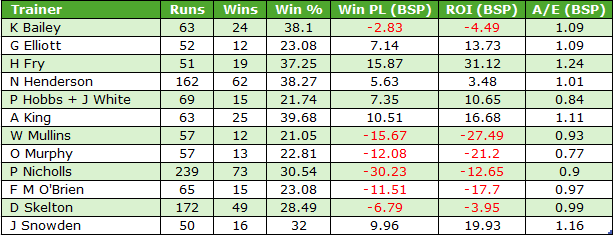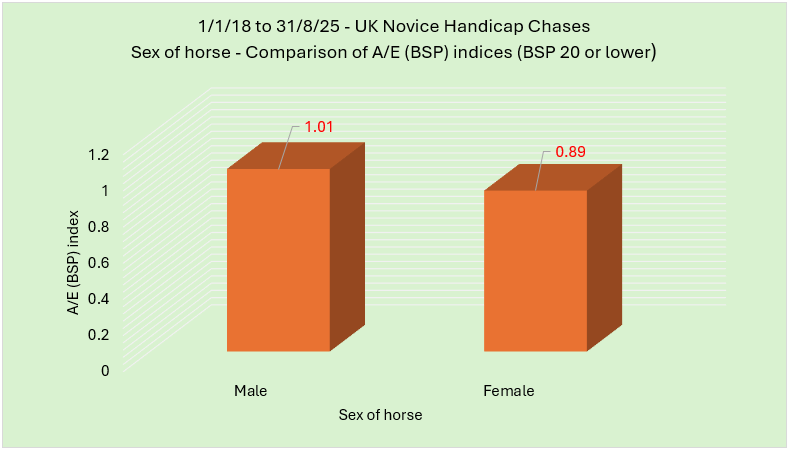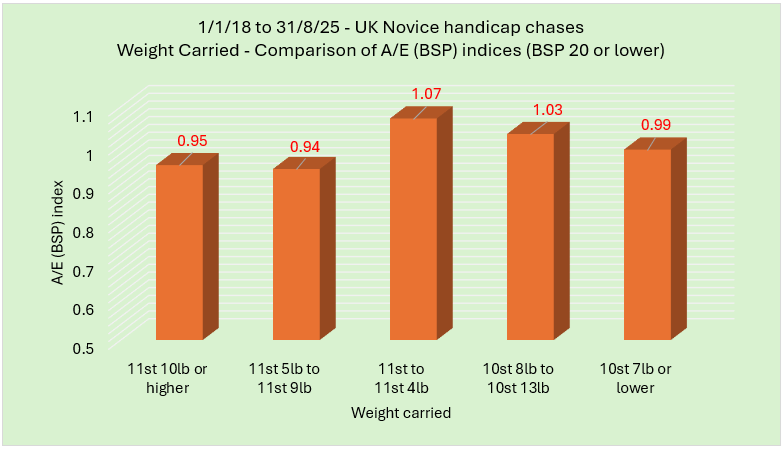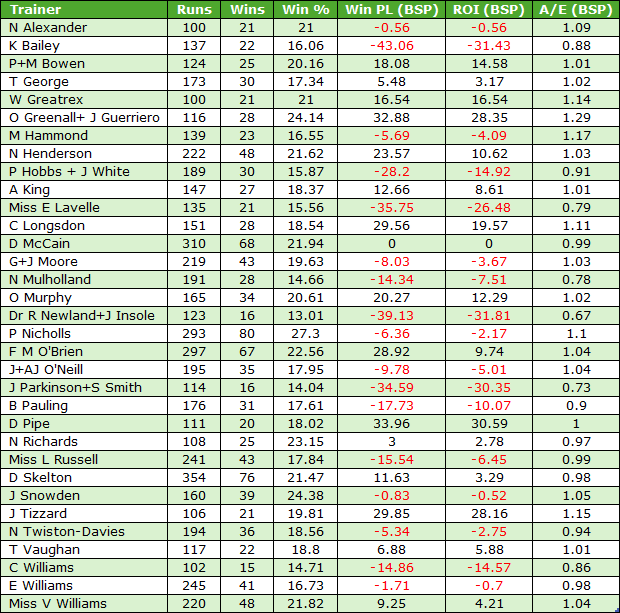Preparing for the jumps – Part 2, Novice Chases
This the second article in a series which is looking forward to the National Hunt season, writes Dave Renham. In the first piece I looked at non-handicap novice hurdle races. In this one, I will focus on novice chasers. I plan to look at both non-handicap and handicap races, starting with the former.
Data has been taken from 1st January 2018 to 31st August 2025 with profits and losses calculated to the Betfair Starting Price (BSP) with a 2% commission applied on any winning bets.
Contents
ToggleNon-handicap Novice Chases
There has been a serious drop in the number of non-handicap novice chases in recent years so good betting opportunities have proved somewhat limited. However, I feel it is still worthwhile sharing my findings and I would like to begin by looking at market factors for all qualifying races.
Market factors
I have used Betfair in terms of market rank and here is the breakdown:
Favourites won roughly 50% of all races and backing all of them would have made a small loss equating to just over a penny in the £. Second favourites offered some value and this was especially true when they had been shorter prices. Second favourites with a BSP of 3.0 or lower won 86 races from 194 runners (SR 44.3%) for a profit of £34.98 (ROI +18%). Meanwhile, backing horses positioned 4th or higher in the betting market would have lost a significant amount. That is despite a good looking A/E index.
Having looked at the overall market, it is time to look into other areas. As with the first article, I am going to impose a BSP price limit of 20.0 or lower from now on, to avoid any winners at excessively big odds potentially skewing the bottom line.
Sex of horse
Does the sex of the horse make a difference? Let’s see:
As can be seen, the ratio of male runners to female is around 6:1. In terms of performance, males have won more often but the bottom lines are very similar, as are the A/E indices.
Age of horse
Let me move onto the age stats now, beginning with the returns across different ages (the BSP ROI percentages):
Note that the 4yo stats are based on just 29 runners, so concentrating on the bigger samples of horses aged five and older, we can see that the trend is the younger the horse the better the returns. Once we get to horses aged nine amd up losses become fairly steep. Here are the full stats, including other key metrics:
It is interesting to note that 5yos have an A/E index below 1. That is surprising based on the strike rate, profit and returns. At the other end of the age spectrum, it does seem that we should be slightly wary of horses aged nine or older.
Country of Breeding
I want to look now at breeding and specifically the country of breeding. Here are the splits for the three main countries:
French breds performed best and showed a healthy profit, while British breds produced the worst returns. French bred runners which won last time out did particularly well, winning once in every three starts (80 wins from 240) for a profit of £71.99 (ROI +30%); A/E (BSP 1.07.
Trainers
Finally for the non-handicap novice chases let's look at some trainer data. Below is a table sharing individual trainer data in non-handicap novice chases during the period of study and with the 20.0 BSP price cap. To qualify a trainer must have had at least 50 such runners during the time frame:
The trainers that stand out are Harry Fry, Alan King and Jamie Snowden with strong metrics across the board. Gordon Elliott’s figures are solid too.
*
Let's now move on to the second part of the article where the focus will be on novice handicap chases. There are around five times the number of these compared to the non-handicap ones, so we have more data as well as more races to potentially attack this winter. I will also be drilling down into some additional areas than I did for the non-handicaps.
Novice Handicap Chases
Market factors
I will start again with market rank. This includes all runners; and, as with the non-handicap novice chases, once we move on from this section I will have imposed the BSP 20.0 price limit:
Favourites have gone close to breaking even, while horses second and third in the betting market have both lost small (and similar) amounts. Those fifth+ in the betting market have made a profit but essentially this boiled down to three winners at BSP 210, 180 and 324.41. Remove that trio and the cohort would have lost money. Hopefully this helps explain the price cap I will be using once more from now on.
Sex of horse
In the non-handicaps discussed earlier there was little in it between male and female runners. Was that the case in novice handicap chases? Let’s compare the strike rates first:
We see a definite edge to male runners this time. How about the A/E (BSP) indices?
Again, there is strong edge here for males, so does this correlate when we look at the profit/loss/ROI% figures? Here are the full splits:
There is a huge discrepancy in terms of the total number of runs for each group, but the male edge is there across the board. For mares, losses of nearly 17p in the £ coupled with a very modest 0.89 A/E index illustrate the struggles they had in such races. I would be wary of backing any female runner in novice handicap chases against the geldings.
Age of horse
We saw earlier that in non-handicap novice chases horses aged nine or older produced the poorest returns by some margin. Was that replicated in handicaps? As before I'll start by sharing the returns across different ages (the BSP ROI percentages):
This time, we see even poorer returns for the aged nine and up group. Losses of more than 18 pence in the £ are negatively noteworthy. Here is the full breakdown for each age group:
4yo runners were again relatively rare but they had the highest win rate, best ROI% and highest A/E index. Hence, it seems those young'uns require at least a second glance. 6yos had a good record and with over 3500 runners in a very decent sized sample; they made a profit to follow blindly in seven of the last eight years. I cannot give a logical reason why 6yos have done so well, except perhaps that this is the optimal year in their career trajectories from young horses graduating from novice or second season hurdlers.
Going back to the older brigade of runners aged 9yo+, they had the lowest strike rate and the poorest A/E index, coupled with those poor returns noted earlier. I would need a good reason to back an older horse in a novice chase of any description based on these numbers.
Country of Breeding
We saw earlier that French bred runners had an edge in non-handicap novice chases. We see a similar pattern in handicap novice chases, too:
The French breds held sway once more with the best figures across all metrics. It should be noted that German bred runners also performed well from a small sample. There were 79 GER-bred runners of which 18 won (SR 22.8%) for a very healthy profit of £51.59 (ROI +65.3%); A/E (BSP) 1.36. With 14 different winning German bred horses and no horse winning more than twice, nothing can be said to have skewed the data.
Going back to French breds, those who raced in a hurdle race last time saw excellent returns of nearly 25p in the £. Over 700 qualifiers there was a profit to BSP of £175.86 (ROI 24.8%); A/E (BSP) 1.17. Also, younger French bred runners fared extremely well with those aged seven or less producing a strike rate of 20.8% (409 wins from 1968 runners) for a profit of £180.10 (ROI +9.2%). Further, this young cohort was consistent with seven profitable years out of the eight - only 2018 producing a loss, and a small one at that.
Position Last Time Out (LTO)
A look now at the most recent piece of form in terms of finishing position LTO.
These splits are interesting. As we would expect, LTO winners had the best strike rate; and last day runners up achieved a better win rate than horses further back (third or worse) on their most recent start. However, those recent 1-2 finishers incurred losses of over 9p in the £ which is well above the norm for such runners: they're clearly over bet. Also, their A/E indices were lower than we would normally see.
The best value was found with horses that finished sixth or worse LTO and I guess some of these have flown under the radar.
Weight Carried
In handicaps horses carry weight based on their Official Rating so I wanted to review this angle. Below are the A/E indices for different weight brackets:
The higher weighted runners seem to have offered the worst value and when we look at the full splits, we see that this is the case:
The best value seems to have been with the mid-range weight bracket of 11st to 11st 4lb, followed by the 10st 8lb to 10st 13lb group. Higher weighted runners (11st 5lb or more) were indeed the worst value.
Trainers
The last port of call for this piece is to review some trainer statistics for novice handicap chases. We have more data to drill into than the ‘nons’ so let me start by sharing trainers who have saddled at least 100 such runners during the time frame. They are ordered alphabetically:
Almost half of the trainers in the table (15 out of 33) recorded a profit with their runners which is a decent effort. Here are a few individual trainer stats worth sharing:
- The Greenall/Guerriero yard have excelled with horses making their second chase start. This cohort won 9 of 24 (SR 37.5%) for a profit of £26.62 (ROI +110.9%); A/E (BSP) 1.96.
- Nicky Henderson had only 28 female runners but 9 won (SR 32.1%) for a profit of £21.10 (ROI +75.4%); A/E (BSP) 1.81. He also performed well with horses making their chasing debut thanks to a 25% strike rate (19 wins from 76) for a profit of £20.74 (ROI +27.3%), A/E (BSP) 1.14.
- The Hobbs/White yard made an overall loss, but when their runners start favourite we should take note. Their market leaders won 13 from 37 (SR 35.1%) for a profit of £13.04 (ROI +35.2%); A/E (BSP) 1.17.
- Paul Nicholls should be noted when saddling the favourite. His record with jollies has been superb. 45 of the 88 won (SR 51.1%) for a healthy profit of £22.83 (ROI +25.9%); A/E (BSP) 1.22.
- Evan Williams has bucked the trend when it comes to last time out winners. His record has been excellent with 13 winners from 40 (SR 32.5%) for a profit of £20.31 (ROI +50.8%); A/E (BSP) 1.63.
- Venetia Williams has done well with horses aged seven or younger. They produced a profit of £31.11 (ROI +20.6%) thanks to 37 winners from 151 (SR 24.5%); A/E (BSP) 1.09.
- Kerry Lee did not make the table due to having saddled just below 100 runners in total, but her favourites did well, winning 12 of 26 starts (SR 46.2%) for a profit of £9.89 (ROI +38%); A/E (BSP) 1.40.
**
That's it for this second part of our 2025/26 NH prep series. There is a banquet of stats and snippets in this piece that hopefully will point us in the right direction when it comes to novice chases this season. Look out for part 3 next week when I'll be lasering in on another cohort of runners performing through the autumn, winter and spring. Until then...
- DR






























![Flooring Porter and Danny Mullins [right] wins the Paddy Power Stayers Hurdle at Cheltenham for a second time from l-r Klassical Dream, Thyme Hill and Champ. 17/3/2022 Pic Steve Davies/Racingfotos.com](https://www.geegeez.co.uk/wp-content/uploads/2024/03/FlooringPorter_Cheltenham_StayersHurdle_2023.png)


Where do your source this date from.HRDB?
Hi, great stuff – also interested how you source and sort this data. Is this an area on Geegeez? Keen to run similar style analysis, but not sure where to start.
Leave a Reply
Want to join the discussion?Feel free to contribute!